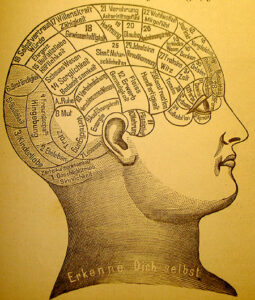FROM GUIDING SYMPTOMS OF OUR MATERIA MEDICA—
Sudden attack of unconsciousness.
Cannot express herself; seems at a loss to know how to begin to say or do what she wishes. θ Puerperal mania.
Absentminded.
Dull, confused, stupid, as after intoxication.
Imagines seeing birds flying in the room; he tries to catch them.
Great aversion to being alone.
Dread of labor.
Weeps much.
Alternating mood, at one time good and quiet, at another excited and angry at trifles; constantly in antagonism with herself; frequently hopeful, frequently despondent; frets about everything; peevish, impatient, contented with nothing. θ Melancholia.
Timid and apprehensive of the future and about her disease.
Fear of being alone; fears she will die.
Anxiety with fear.
Despondency in the open air; disappears on entering the house.
Peevish, irritable; noise is disagreeable; easily startled, especially if touched; intolerance of human voice.
Irascible and passionate.
Very easily frightened; shrieks about imaginary appearances; starts when touched.
Is frightened and cries out whenever he is touched lightly on his feet.
Delirium in the night. θ Pleurisy.
SEE SOME SIMPLE UNDERSTANDING OF SOME SELECTED POINTS:
A======
- Sudden attack of unconsciousness: This means a person experiences a sudden loss of consciousness, where they become unaware of their surroundings and cannot respond or react.
- Cannot express herself; seems at a loss to know how to begin to say or do what she wishes: This indicates that the person is having difficulty expressing themselves verbally or taking action. They may feel unsure about how to start or communicate their thoughts and desires.
- Puerperal mania: This term refers to a condition where a woman experiences mental disturbances after childbirth.
- Absentminded: This means being forgetful or preoccupied, often not paying attention to one’s surroundings or tasks.
- Dull, confused, stupid, as after intoxication: This describes a state of mental dullness, confusion, or feeling slow and unintelligent, similar to how one might feel after consuming alcohol or drugs.
- Imagines seeing birds flying in the room; he tries to catch them: This suggests that the person has hallucinations or false perceptions of birds flying in the room, and they make attempts to catch them even though the birds are not actually there.
- Great aversion to being alone: This means a strong dislike or fear of being by oneself and preferring the company of others.
- Dread of labor: This refers to feeling intense fear or anxiety about the process of giving birth.
- Weeps much: This indicates that the person cries frequently or excessively.
- Alternating mood: The person’s mood changes frequently, shifting between different emotional states. At times, they may be calm and peaceful, while at other times, they may become easily agitated and angry over small things. They constantly experience conflicting emotions and can feel hopeful or despondent. They may worry about everything, be irritable, impatient, and find contentment in nothing. This is associated with the condition of melancholia, a form of depression.
- Timid and apprehensive about the future and their disease: The person feels fearful and anxious about what lies ahead and about their illness or condition.
- Fear of being alone; fears she will die: This means that the person is afraid of being by themselves and has a fear of dying.
- Anxiety with fear: The person experiences a state of anxiousness accompanied by fear.
- Despondency in open air; disappears on entering the house: When the person is outside in open spaces, they feel a sense of sadness or hopelessness. However, this feeling goes away once they enter a house or enclosed space.
- Peevish, irritable; noise is disagreeable; easily startled, especially if touched; intolerance of human voice: The person is easily annoyed, irritable, and finds noise unpleasant. They may get startled easily, especially if someone touches them. They have a low tolerance for the sound of human voices.
- Irascible and passionate: This means that the person has a quick temper and strong emotions, which they express passionately.
- Very easily frightened; shrieks about imaginary appearances; starts when touched: The person is highly susceptible to fear and gets frightened very easily. They may scream or make loud noises in response to imaginary things they see. They also get startled when touched.
- Delirium in the night: This refers to a state of confusion, restlessness, and sometimes hallucinations that occur during the night.
- θ Pleurisy: The symbol “θ” indicates a connection or association with pleurisy, which is an inflammation of the lining of the lungs.
B =========
- ⭐ Sudden attack of unconsciousness: This symbol signifies the importance of paying attention to sudden changes in our health, like a sudden loss of consciousness, which should be taken seriously and addressed promptly.
- 💬 Cannot express herself; seems at a loss to know how to begin to say or do what she wishes: This symbol highlights the significance of effective communication, where expressing oneself clearly and confidently is crucial for conveying thoughts, needs, and desires.
- 🤰 Puerperal mania: This symbol represents a condition that some women may experience after childbirth, emphasizing the need for awareness and understanding of mental health challenges during the postpartum period.
- 🧠 Absentminded: This symbol reminds students about the importance of mindfulness and concentration, encouraging them to stay focused and attentive in their studies and daily activities.
- 🍺 Dull, confused, stupid, as after intoxication: This symbol raises awareness about the potential consequences of substance abuse and the importance of making responsible choices to maintain mental clarity and well-being.
- 🦅 Imagines seeing birds flying in the room; he tries to catch them: This symbol represents the power of imagination and highlights the need to differentiate between reality and imagination. It encourages students to nurture their creativity while staying grounded in the real world.
- 🙅♀️ Great aversion to being alone: This symbol highlights the significance of social connection and support, reminding students to value relationships and seek companionship while respecting their need for personal space.
- 💔 Dread of labor: This symbol signifies the anxieties and concerns associated with facing challenging tasks or situations. It reminds students to approach difficulties with resilience and seek support when needed.
- 😢 Weeps much: This symbol represents the importance of acknowledging and expressing emotions. It encourages students to seek emotional support when feeling overwhelmed and promotes empathy towards others who may be experiencing similar emotions.
- 🌈 Alternating mood: This symbol represents the fluctuation of emotions that individuals may experience, reminding students to be patient with themselves and others during times of emotional change. It encourages empathy and understanding.
- 😟 Timid and apprehensive about the future and their disease: This symbol emphasizes the significance of addressing fears and concerns about the future, promoting a sense of optimism and resilience in the face of uncertainty.
- 👻 Fear of being alone; fears she will die: This symbol raises awareness about the fear of isolation and mortality. It reminds students to support and include others, promoting a sense of belonging and security.
- 😰 Anxiety with fear: This symbol highlights the challenges of anxiety and fear, promoting the importance of mental well-being and seeking appropriate help and support.
- 🌳 Despondency in open air; disappears on entering the house: This symbol represents the impact of surroundings on our emotions. It encourages students to find solace and comfort in their home environment while also appreciating the positive influence of nature and outdoor spaces.
- 🙉 Peevish, irritable; noise is disagreeable; easily startled, especially if touched; intolerance of human voice: This symbol raises awareness about sensory sensitivities and encourages students to be mindful of creating a conducive and respectful learning environment for everyone.
- 🔥 Irascible and passionate: This symbol represents the power of passion and strong emotions, reminding students to channel their emotions effectively and find constructive outlets for their energy.
- 😱 Very easily frightened; shrieks about imaginary appearances; starts when touched: This symbol emphasizes the significance of empathy and understanding towards individuals who may be more sensitive or easily frightened. It encourages students to create a safe and inclusive environment for everyone.
 🌙 Delirium in the night: This symbol raises awareness about the importance
🌙 Delirium in the night: This symbol raises awareness about the importance


